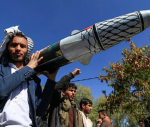You are here
Uzbekistan's good crisis
Aug 20,2022 - Last updated at Aug 20,2022
BISHKEK — Earlier this summer, protests erupted in Uzbekistan’s autonomous Republic of Karakalpakstan after the government announced plans to strip the region of its constitutional status. Viewing the move as a blow to their identity, the people of Karakalpakstan, especially ethnic Karakalpaks, took to the streets and clashed with the police and security forces, leaving 18 dead and 243 injured, including 38 law-enforcement officers.
The episode was both horrific and a notable improvement from 2005, when Uzbek government forces killed hundreds of unarmed protesters in the city of Andijan. The official death toll was 189, but witnesses say the real figure is much higher. Not only were there far fewer casualties this time around; Uzbek authorities were quick to share sensitive details of the event.
Moreover, President Shavkat Mirziyoyev swiftly agreed to the protesters’ demands, declaring that Karakalpakstan would retain its autonomous status. This brought the unrest to a rapid end. In fact, Mirziyoyev lifted the month-long state of emergency he declared on July 2 after less than three weeks.
This is no small feat, especially given the region’s history of ethnic conflict. To appreciate it, one need only recall the clashes between Uzbeks and Meskhetian Turks in Uzbekistan in 1989, and between ethnic Uzbeks and Kyrgyz in the Osh region of Kyrgyzstan in 1990 and 2010.
The Uzbek authorities’ success in restoring stability drew praise from the leaders of Uzbekistan’s Central Asian neighbours. Russian President Vladimir Putin also weighed in, as did China’s foreign ministry. The United States and the European Union, however, expressed concern over the violence and called for a full, credible, and transparent investigation into the events.
The prospect of losing autonomous status clearly spurred the protests in Karakalpakstan. But on July 6, Mirziyoyev’s press secretary, Sherzod Asadov, suggested that the upheaval was “prepared for years by foreign forces”, whose “main goal is to encroach on the territorial integrity of Uzbekistan and create an inter-ethnic conflict”.
This might call to mind accusations made by then-president Islam Karimov after the Andijan violence: Western powers, he claimed, were attempting to orchestrate a “colour revolution.” (The episode upended Uzbekistan’s relations with the West for at least a decade.) But Mirziyoyev is no Karimov.
Since coming to power in 2016, Mirziyoyev has promoted regional cooperation, released political prisoners, introduced measures to ban forced labour, improved media freedom, and implemented many more positive reforms. In 2019, foreign direct investment in Uzbekistan increased by more than 150 per cent, and The Economist named Uzbekistan the world’s “most improved” country.
Mirziyoyev wants to be taken seriously as a progressive and trustworthy leader, so could his government’s claims about the protests be true? One should first consider which outside force could possibly orchestrate such large protests. Uzbekistan is no fledgling state: Unlike its Central Asian neighbours, statehood preceded the arrival of the Russian Empire. And since not just anyone can undermine the unity of a mature country, the most likely culprit would be a major foreign power, even a global superpower.
But regional destabilisation is not in the interest of Uzbekistan’s giant neighbors, Russia and China. Both would prefer a prosperous and confident Central Asia to a poor and volatile region, which could become a source of extremism, terrorism, poverty and mass migration.
The same is true of the West, which has always supported Central Asian countries’ independence and development, and thus have no reason to oppose Mirziyoyev. In fact, the US and Europe are the leading foreign investors in the region, by a large margin. With Russia and China also holding major stakes in Uzbekistan’s economy, it seems unlikely that any of the world’s biggest powers would be eager to sow instability there.
It is far more likely that the recent protests were driven mainly by widespread poverty, high unemployment, and climate change. While recent reforms are undoubtedly a step in the right direction, economic development will take time.
The good news is that Uzbekistan has significant economic potential, not least owing to considerable primary energy resources. The country’s proven reserves are estimated at about 1.8 trillion cubic metres of gas, 600 million barrels of oil, and 1.9 billion tonnes of coal. Karakalpakstan, in particular, is home to substantial natural-gas fields, the development of which would create jobs and fill the regional government’s coffers.
But, as neighbouring Kazakhstan’s experience shows, hydrocarbon-rich countries are hardly immune to protests. And the people of Karakalpakstan have plenty of other grievances. The desiccation of the Aral Sea has caused widespread land degradation and desertification, and also resulted in the release of toxic chemicals that accumulated in the lake (once the world’s fourth-largest) during Soviet times, when upstream farmers used pesticides intensively to increase crop yields. As a result, the people of Karakalpakstan suffer from water shortages and poor health.
Climate change will exacerbate these trends. It is estimated that, by 2050, Central Asia will have lost two-thirds of its glaciers, and thus its water, relative to 1960 levels.
But, aside from natural resources, Uzbekistan stands to benefit from a population that understands what it means to be a unified people under a single government. And it has leaders who are committed to preserving their country’s independence and advancing its development. One hopes that, far from being a harbinger of further unrest, the recent violence spurs more positive reforms.
Djoomart Otorbaev is a former prime minister of Kyrgyzstan. Copyright: Project Syndicate, 2022.











